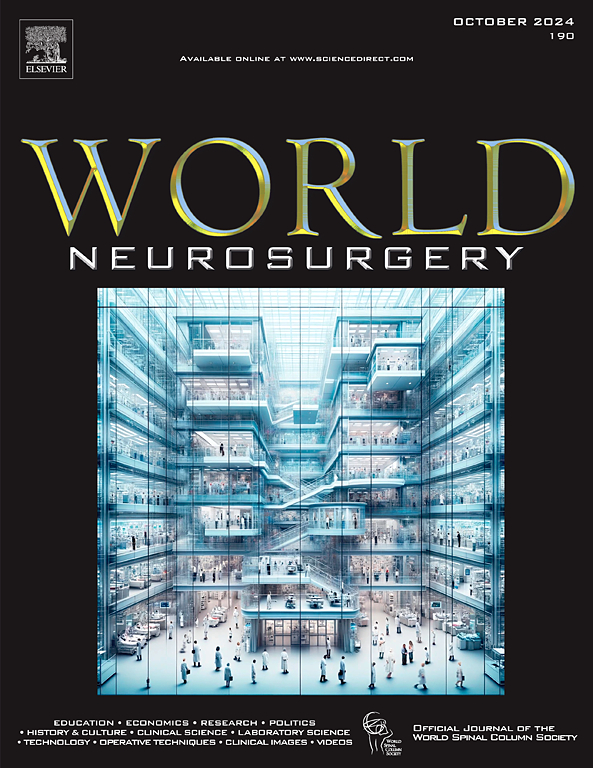外周血炎症指标对基底节脑出血外周水肿生长距离及预后的影响
IF 1.9
4区 医学
Q3 CLINICAL NEUROLOGY
引用次数: 0
摘要
背景:探讨中性粒细胞与淋巴细胞比值(NLR)、淋巴细胞与单核细胞比值(LMR)、血小板与淋巴细胞比值(PLR)、血肿周围水肿(PHE)、水肿延伸距离(EED)、EED生长及功能预后等外周血炎症标志物对基底神经节出血患者的影响。方法:回顾性收集当图县人民医院神经外科2017年1月至2023年6月收治的基底神经节脑出血患者的临床资料。主要结局是绝对PHE、相对PHE、EED和EED生长。次要终点是出院后90天的临床状况,使用改良的Rankin量表(mRS)进行评估。mRS评分3-6分表明功能预后不良。结果:共纳入83例基底节区脑出血患者,中位年龄67.0岁(四分位数范围58.0 ~ 73.0),男性占75.9%。在90天的随访中,48例患者(57.8%)出现功能不良(mRS 3-6)。单变量线性回归分析显示,在基线和24-72小时测量时,炎症比率(NLR、LMR和PLR)与PHE动力学之间没有显著关联。调整后的多因素logistic回归分析确定基线NLR和PLR是基底节区脑出血(ICH)的独立预测因子。受试者工作特征曲线分析显示,基线NLR具有较好的判别能力(曲线下面积[AUC]=0.854;95%可信区间[CI], 0.767-0.927),与PLR (AUC=0.787;95% CI, 0.689-0.874)和血肿体积(AUC=0.788;95% ci, 0.676-0.881)。最佳预后阈值为NLR=5.90, PLR=141.53,血肿体积=10.40 ml。结论:NLR、LMR和PLR虽不是基底节区脑出血PHE进展的独立预测指标,但它们可作为基底节区血肿患者预后的简单、无创工具。通过识别需要加强监测或早期神经保护干预的患者,可以加强风险分层。本文章由计算机程序翻译,如有差异,请以英文原文为准。
Influence of Peripheral Blood Inflammatory Indices on the Distance of Growth and Prognosis of Peripheral Edema in Basal Ganglia Cerebral Hemorrhages
Background
To investigate the effects of peripheral blood inflammatory markers, such as the neutrophil-to-lymphocyte ratio (NLR), lymphocyte-to-monocyte ratio (LMR), platelet-to-lymphocyte ratio (PLR), perihematomal edema (PHE), edema extension distance (EED), EED growth, and functional prognosis in patients with basal ganglia hemorrhage.
Methods
The clinical data of patients with basal ganglia cerebral hemorrhage observed in the Department of Neurosurgery at Dangtu County People's Hospital between January 2017 and June 2023 were retrospectively collected. The primary outcomes were absolute PHE, relative PHE, EED, and EED growth. The secondary outcome was the clinical status 90 days postdischarge, assessed using the modified Rankin scale (mRS). Scores of 3–6 on the mRS indicate unfavorable functional outcomes.
Results
A total of 83 patients with basal ganglia cerebral hemorrhage were enrolled, with a median age of 67.0 years (interquartile range, 58.0–73.0) and 75.9% male predominance. Poor functional outcomes (mRS 3–6) were observed in 48 patients (57.8%) at the 90-day follow-up. Univariate linear regression analysis revealed no significant association between inflammatory ratios (NLR, LMR, and PLR) and PHE dynamics at both baseline and 24–72 hours measurements. Adjusted multivariate logistic regression analysis identified the baseline NLR and PLR as independent predictors of intracerebral hemorrhage in the basal ganglia. Receiver operating characteristic curve analysis revealed that baseline NLR had superior discriminative capacity (area under the curve [AUC] = 0.854; 95% confidence interval [CI], 0.767–0.927) compared to PLR (AUC = 0.787; 95% CI, 0.689–0.874) and hematoma volume (AUC = 0.788; 95% CI, 0.676–0.881). The optimal prognostic thresholds were NLR = 5.90, PLR = 141.53, and hematoma volume = 10.40 ml.
Conclusions
Although NLR, LMR, and PLR were not independent predictors of PHE progression in basal ganglia cerebral hemorrhage, they can be used as simple, noninvasive tools to predict the prognosis of patients with basal ganglia hematomas. Risk stratification can be enhanced by identifying patients requiring intensified monitoring or early neuroprotective interventions.
求助全文
通过发布文献求助,成功后即可免费获取论文全文。
去求助
来源期刊

World neurosurgery
CLINICAL NEUROLOGY-SURGERY
CiteScore
3.90
自引率
15.00%
发文量
1765
审稿时长
47 days
期刊介绍:
World Neurosurgery has an open access mirror journal World Neurosurgery: X, sharing the same aims and scope, editorial team, submission system and rigorous peer review.
The journal''s mission is to:
-To provide a first-class international forum and a 2-way conduit for dialogue that is relevant to neurosurgeons and providers who care for neurosurgery patients. The categories of the exchanged information include clinical and basic science, as well as global information that provide social, political, educational, economic, cultural or societal insights and knowledge that are of significance and relevance to worldwide neurosurgery patient care.
-To act as a primary intellectual catalyst for the stimulation of creativity, the creation of new knowledge, and the enhancement of quality neurosurgical care worldwide.
-To provide a forum for communication that enriches the lives of all neurosurgeons and their colleagues; and, in so doing, enriches the lives of their patients.
Topics to be addressed in World Neurosurgery include: EDUCATION, ECONOMICS, RESEARCH, POLITICS, HISTORY, CULTURE, CLINICAL SCIENCE, LABORATORY SCIENCE, TECHNOLOGY, OPERATIVE TECHNIQUES, CLINICAL IMAGES, VIDEOS
 求助内容:
求助内容: 应助结果提醒方式:
应助结果提醒方式:


